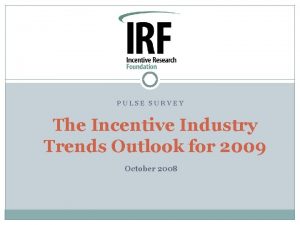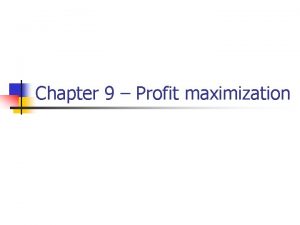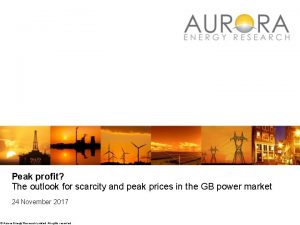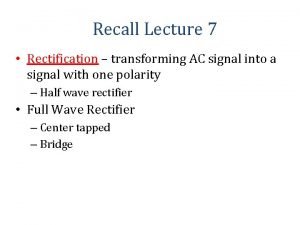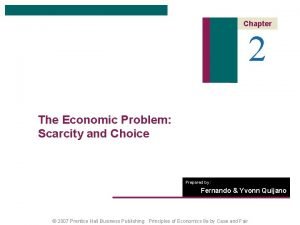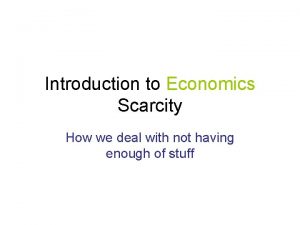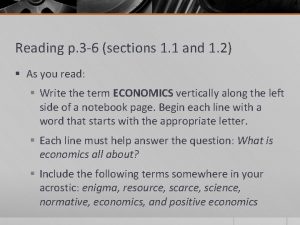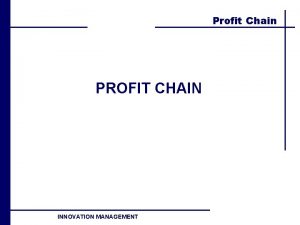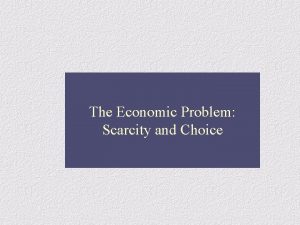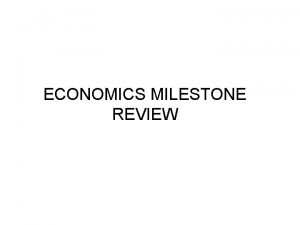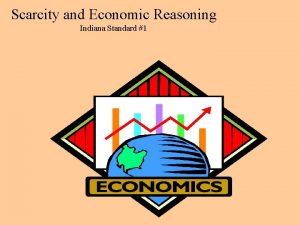Peak profit The outlook for scarcity and peak


















- Slides: 18

Peak profit? The outlook for scarcity and peak prices in the GB power market 24 November 2017 © Aurora Energy Research Limited. All rights reserved.

Agenda 1. Context: Price volatility increased markedly in winter 2016/17, leading to an almost four-fold increase in energy market margins for peakers 2. Key drivers: 2016/17 saw a perfect storm of factors driving price spikes above historical norms 3. Outlook: a return to 2016/17 prices is unlikely in the short term, but price spread will increase in the long term due to the growth of renewables 4. Investment: the persistence of peak prices will critically affect investment in flexible technologies, as well as CM bidding strategies 2

Winter 2016/17 saw volatility and peak prices not seen since 2008 APX price, monthly £/MWh Percentiles 1 Mean 99 th 1 st 99 th percentile reaches £ 243 in Nov 2016 Ja n 07 Daily price volatility 2 Ja n 09 2008/09 159% Ja n 11 2014/15 87% Ja n 13 2015/16 106% Ja n 15 § Winter 2016/17 saw wholesale prices spike to a maximum of £ 792/MWh, with the top percentile of prices reaching £ 243/MWh in November 2016 § Price volatility doubled in 2016/17 compared to 2014/15 Ja n 17 2016/17 170% 1. Chart shows monthly percentiles. For example, the 99 th percentile is the value that 99% of HH APX values were below for that month. 2. Volatility calculations take the logarithmical differences of daily average prices for consecutive trading days, and the relative standard deviation over a year, as per European Commission methodology. Source: Aurora Energy Research 3

Higher peak prices in 2016/17 quadrupled gross margins of gas recips. and doubled that of CCGTs Energy market gross margins 1, (£k/MW/year) Gas recip. 3 Percentiles of spot price 2 +284% 2016/17 0 -99 th CCGT 4 +96% 2015/16 99 th 2015/16 § Relative to the previous year, 2016/17 saw energy market profits increasing by ~300% for a gas recip. and nearly ~100% for a CCGT § A gas recip participating in the day-ahead, intraday and balancing markets could have made ~33% of its annual margins when power prices were above the 99 th percentile in 2016/17 1. Analysis done by using an asset-dispatch model against historic prices. 2. Percentiles based all half-hour APX across the year, not just those where plant is running. Only considers potential revenues from energy trading between day-ahead, intra-day and balancing markets. Ramping costs excluded. 3. Representative gas recip with 39% HHV efficiency. 4. Representative high-merit CCGT with 54% HHV efficiency. Sources: Aurora Energy Research, Elexon 4

Agenda 1. Context: Price volatility increased markedly in winter 2016/17, leading to an almost four-fold increase in energy market margins for peakers 2. Key drivers: 2016/17 saw a perfect storm of factors driving price spikes above historical norms 3. Outlook: a return to 2016/17 prices is unlikely in the short term, but price spread will increase in the long term due to the growth of renewables 4. Investment: the persistence of peak prices will critically affect investment in flexible technologies, as well as CM bidding strategies 5

Winter 2016/17 saw a perfect storm of factors driving higher wholesale and system prices 1 2 SBR took 4 GW of capacity out of the market Coal plants were not ready in autumn Coal weekly max MEL 1, GW 25 Total contracted SBR capacity, MW Capacity MEL 20 Oct 16: 7 GW of coal available 15 10 5 0 14/15 3 15/16 16/17 Damaged French interconnector limited imports…. 4 Ja Mar May Jul Se Nov Ja Mar n 16 16 16 p 16 n 17 16 16 17 … whilst nuclear outages in France led to I/C exports Imports via France Interconnector, TWh Available capacity of interconnector to France, GW 20 Nov 16: IFA 2 I/C damaged 28 Sept 16: EDF announces 12 reactors offline 3 2 1 1 0 0 15 Nov 20 Nov 25 Nov 30 Nov 5 Dec 1. Maximum aggregated MEL reported by coal plants in any period across a month. Source: Aurora Energy Research -1 Mar 15 Se p 15 Mar 16 Se p 16 Mar 17 CONFIDENTIAL: NOT FOR EXTERNAL DISTRIBUTION Se p 17 6

In addition to merit order effects, these factors increased components of ‘uplift’, pushing up market prices Uplift Illustrative supply stack 1 Demand Price, £/MWh Electricity price System Marginal Cost Uplift Illustrative Ramping cost: the additional costs from increasing output to deliver at peak times 2 Imbalance cost: wholesale bids reflect the cost and risk of being out of balance in the BM 3 Opportunity cost: the trade off between selling in the wholesale versus balancing market 4 Imperfect competition: the ability to price above marginal cost due to weak competition, portfolio concentration and/or information asymmetry Marginal Cost Instantaneous cost of operating: Fuel + CO 2 + VOM + BSUo. S + Embedded Benefits + Variable subsidies Sources: Aurora Energy Research 7

1 Ramping costs explain the majority of uplift on average, but contribute little to the very top prices Proportion of average wholesale price in winter 2016/171, % All prices § § Uplift § Top 1 percentile of prices § Uplift SRMC 2 Ramping cost 3 Other In general, ramping costs explain 60% of total uplift in winter 2016/17 However, this relationship breaks down in periods of high peak prices, as other factors dominate In the top 1 price periods in winter 2016/17, ramping costs accounted for less than 20% of total uplift Ramping costs were particularly high in the early part of Winter 2016/17 as coal plants were offline, whilst demand increased early in the season Wholesale price 1. Analysis performed using historical APX prices between Oct 2016 – March 2017 inclusive, only considering periods where wholesale prices are greater than short-run marginal costs. 2. Short Run Marginal Cost 3. Ramping cost defined as the incremental cost to a system if an additional MW of generation is required. Proportion accrued towards ramping costs is based on “shadow price” analysis. Sources: Aurora Energy Research 8

2 Imbalance costs Generators must factor in the risk of high imbalance cost into their wholesale bids, driving up wholesale prices Uplift required in EM, £/MWh Probability of tripping/being short in EM 2016/17 (avg system short price) 2016/17 (top 1% system short price) 2015/16 (avg system short price) 2015/16 (top 1% system short price) Sources: Aurora Energy Research § Generators must factor in the probability-weighted cost of imbalance into their EM pricing decisions § On average, system short prices were ~£ 21/MWh higher in 2016/17 § During periods of high expected system prices, generators must factor in higher imbalance costs § For instance, if generator expects to trip with 10% probability during top 1 percentile of system prices in 2016/17, an additional £ 29/MWh will be required in the EM § The risk of tripping was higher for coal plants coming online from cold in Autumn 2016 CONFIDENTIAL: NOT FOR EXTERNAL DISTRIBUTION 9

Agenda 1. Context: Price volatility increased markedly in winter 2016/17, leading to an almost four-fold increase in energy market margins for peakers 2. Key drivers: 2016/17 saw a perfect storm of factors driving price spikes above historical norms 3. Outlook: a return to 2016/17 prices is unlikely in the short term, but price spread will increase in the long term due to the growth of renewables 4. Investment: the persistence of peak prices will critically affect investment in flexible technologies, as well as CM bidding strategies CONFIDENTIAL: NOT FOR EXTERNAL DISTRIBUTION 10

CM will deliver a high margin in 2017/18; this could persist if NG and BEIS stick to current methodology De-rated margin GW § Winter 2016/17 § NG recommended 4 SBR NG base Winter Outlook (Oct 2016) LOLE Hours 0. 51 Winter Review 2 (June 2017) 0. 05 Embedde CCGT/Biomass Winter 3 d storage Outlook (Oct 2017) In 2016/17, NG estimated de -rated margin without SBR to be 1. 1%, with 8. 8 hours Lo. LE With CM in place in 2017/18, the margin is expected to be higher, with Lo. LE of only 0. 01 hours - significantly lower than the reliability standard of 3 hours. This is due to two main factors: – NG’s methodology assumes downside scenario, hence overprocures capacity needed to hit 3 hours Lo. LE in Base Case 5 – Additional capacity operating without CM contract 0. 01 1. LOLE without SBR estimated to be 8. 8 hours. 2. NG Winter Review estimated a de-rated margin of 3. 7– 4. 9 GW. 3. Between the Winter Review and Winter outlook, NG revised the margin upwards by 1. 3 GW due to lower embedded generation and more CCGTs/Biomass conversion staying on without CM contracts. Actual GWs estimated based on stated de-rated margins. 4. In its Electricity Capacity Report in 2016, NG recommends securing a total 64. 4 GW de-rated capacity against ACS peak of 60. 5 GW, based on the Cold Winter Base Case. 5. National Grid considers over 20 scenarios, indicating the total de-rated capacity in each to meet the 3 hours LOLE reliability standard. A “Least Worst Regret (LWR)” tool is then used to calculate the appropriate level of capacity to secure to meet the Reliability Standard that minimises regret costs of that decision. Sources: Aurora Energy Research 11

Net imbalance volumes (NIV) and balancing costs are expected to rise with growth of intermittent renewables 2020 2030 Long Short Net Imbalance Volume (NIV) Half-hourly, MWh 0% 50% § Long and short imbalance is expected to increase in the period to 2040 § NIV is expected to become more symmetric, but with a moderate leaning to being long due to asymmetric penalty prices § Deployment of flexible capacity is unable to fully offset the higher levels of imbalance resulting from greater intermittent renewables penetration 100% Percentage of time in year Sources: Aurora Energy Research, Elexon CONFIDENTIAL: NOT FOR EXTERNAL DISTRIBUTION 12

Overall a return to 2016/17 peak prices is unlikely in the short term, but we expect price spread to increase in the long term Yearly wholesale prices £/MWh 2015 2020 Sources: Aurora Energy Research Percentiles Historic 2025 2030 1% 99% 2035 § Winter 2016/17 saw a perfect storm of factors leading to a surge in peak prices § Prices have now returned to pre -2016 norms § In the short to medium term, a return to 2016/17 pricing is unlikely (under normal market conditions) § We expect the price spread to increase through the 2020 s, principally driven by the growth in renewables 2040 13

Agenda 1. Context: Price volatility increased markedly in winter 2016/17, leading to an almost four-fold increase in energy market margins for peakers 2. Key drivers: 2016/17 saw a perfect storm of factors driving price spikes above historical norms 3. Outlook: a return to 2016/17 prices is unlikely in the short term, but price spread will increase in the long term due to the growth of renewables 4. Investment: the persistence of peak prices will critically affect investment in flexible technologies, as well as CM bidding strategies 14

Discount rates for peakers need to reflect the risks associated with reliance on peak prices PV of new-build in 20211, £/k. W Percentile of spot price 2 99 -100 Other 3 Gas recip Gross Margin Cost 0 -99 CAPEX FOM NPV, £/k. W Gas Recip. Battery Gross Margin Cost A generic gas recip. is expected to derive 24% of future discounted margins from the top 1 percentile of prices (20% for a battery) Discount rate for 99 -100 percentile prices A typical battery project (built in 2021) becomes unviable if revenues from the top 1 percentile of prices are discounted at over 20% 1. Both BM and EM revenues considered. Discount factor of 6% applied to Capacity Market revenue and costs, 11% applied to remaining margin. Project lifetime of 20 years for gas recip. and, 13 years for batteries, starting from 2021. 2. Percentiles based on all half-hour APX across the year, not just those where plant is running. 3. Other includes Capacity Market contracts and embedded benefits. 4. Gas reciprocating engine with 38% efficiency. 5. Lithium Ion battery with 1 hour storage operating at 85% efficiency and an arbitrage business model. Sources: Aurora Energy Research CONFIDENTIAL: NOT FOR EXTERNAL DISTRIBUTION 15

Key Takeaways Winter 2016/17 saw power prices peak to levels not seen since 2008, with the wholesale price hitting £ 792/MWh and system prices reaching £ 1, 500/MWh Peak prices are the key uncertainty for investment in thermal assets: higher peak prices in 2016/17 quadrupled gross margins of gas recips. and doubled that of CCGTs, relative to the previous year Whilst we expect price volatility to increase in the long term due to the growth of renewables, a return to 2016/17 peak prices is unlikely in the short term Investors need to properly consider the risks associated with reliance on peak prices: a typical peaker derives nearly a quarter of its gross margins from the top 1% of prices Source: Aurora Energy Research 16

Aurora’s products and services Subscription services Comprehensive service package for all power market participants to keep you up-to-date with latest views and trends GB Power Market Service § Quarterly Market Forecasts to 2040 including prices, price shape, spreads, capacity and generation mix development, capacity market results, capture prices for all technologies § Regular policy updates and resulting implications Commissioned Projects Bespoke analytics and advisory services, combining the power of Aurora’s market forecasting with experienced expert consultants § Due diligence, transaction support and valuation § Strategic Insight Reports focussing on topical issue in Power § Revenue stream forecasts Sector (eg. Carbon pricing, Subsidy-free renewables, CM) specific to your project and investment case stress§ Extensive interaction through Group Meeting Discussions, testing bilateral workshops and on-going analyst support Comprehensive service package for developers and investors in battery storage, peaking plants and DSR GB Distributed and Flexible Energy Service § Granular Market Forecasts to 2040 incl. revenue forecasts for the wholesale market, balancing mechanism, capacity market, ancillary services – industry-standard and bankable § Forecast Data in xls to build your own business case § Market, policy and technology outlook § Monthly FFR and balancing mechanism analysis package § Capacity market and ancillary service auction bidding support § Policy analysis, public reports, strategy and more § Experience covers batteries, peakers, renewables, pumped storage, OCGT, flexible CCGT, waste from energy, DSR § Interaction with Aurora team to keep you up-to-date with this rapidly evolving market Contact sebastian. just@auroraer. com for more information or visit auroraer. com 17

Copyright and disclaimer General Disclaimer This document is provided “as is” for your information only and no representation or warranty, express or implied, is given by Aurora Energy Research Limited (“Aurora”), its directors, employees, agents or affiliates (together its “Associates”) as to its accuracy, reliability or completeness. Aurora and its Associates assume no responsibility, and accept no liability for, any loss arising out of your use of this document. This document is not to be relied upon for any purpose or used in substitution for your own independent investigations and sound judgment. The information contained in this document reflects our beliefs, assumptions, intentions and expectations as of the date of this document and is subject to change. Aurora assumes no obligation, and does not intend, to update this information. Forward looking statements This document contains forward-looking statements and information, which reflect Aurora’s current view with respect to future events and financial performance. When used in this document, the words "believes", "expects", "plans", "may", "will", "would", "could", "should", "anticipates", "estimates", "project", "intend" or "outlook" or other variations of these words or other similar expressions are intended to identify forward-looking statements and information. Actual results may differ materially from the expectations expressed or implied in the forwardlooking statements as a result of known and unknown risks and uncertainties. Known risks and uncertainties include but are not limited to: contractual risks, creditworthiness of customers, performance of suppliers and management of plant and personnel; risk associated with financial factors such as volatility in exchange rates, increases in interest rates, restrictions on access to capital, and swings in global financial markets; risks associated with domestic and foreign government regulation, including export controls and economic sanctions; and other risks, including litigation. The foregoing list of important factors is not exhaustive. Copyright This document and its content (including, but not limited to, the text, images, graphics and illustrations) is the copyright material of Aurora [, unless otherwise stated]. No part of this document may be copied, reproduced, distributed or in any way used for commercial purposes without the prior written consent of Aurora. 18
 Outlook for corporate incentive travel programs
Outlook for corporate incentive travel programs Normal profit economics
Normal profit economics Economic profit vs accounting profit
Economic profit vs accounting profit Post acquisition profit is which profit
Post acquisition profit is which profit Peak profit
Peak profit Ac rms voltage
Ac rms voltage Peak to peak voltage
Peak to peak voltage Widows peak dominant
Widows peak dominant Wjat is economics
Wjat is economics Explain scarcity and choice
Explain scarcity and choice Scarcity, choice and opportunity cost example
Scarcity, choice and opportunity cost example Concept of opportunity cost
Concept of opportunity cost Causes of scarcity
Causes of scarcity The basic economic problem results from scarcity.
The basic economic problem results from scarcity. Scarcity lesson plan
Scarcity lesson plan Trade off and opportunity cost
Trade off and opportunity cost Causes of scarcity
Causes of scarcity Scarcity in a sentence
Scarcity in a sentence Scarcity forces tradeoffs symbol
Scarcity forces tradeoffs symbol
